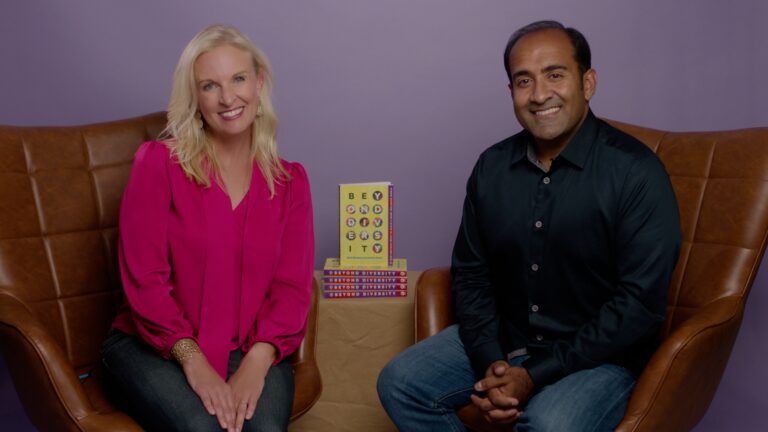Below is an excerpt from Beyond Diversity: 12 Non-Obvious Ways to Build a More Inclusive World, a new book out by Jennifer Brown and Rohit Bhargava.
This book introduction is illustrative of one of the key concepts often overlooked in discussions around creating inclusivity and belonging – searching for and finding the numerous things we all share in common, and seeking to understand and support the things we may not share in common. Intersectionality, by definition, “refers to the idea that none of us can be defined by a single label, but only through a combination of social identities.” It all but forces us to look at each through multiple lenses, and, most importantly, to listen.
“Sometimes the assumptions we make about others come not from what we have been told or what we have seen on television or in books, but rather from what we have not been told.” – Dr. Beverly Daniel Tatum, Author and Psychologist
On a cavernous soundstage in Denmark, groups of people file in one by one. They are clearly different from one another. One group walks in with tattoos. Another, all female, is wearing medical uniforms in various colors. There is an all-White group, right alongside one that includes people visibly from multiple ethnicities. Each group stands apart, staring uncomfortably at one another for what seems like an eternity.
Finally, a host comes in to explain what is about to happen.
“I’m going to ask you some questions today,” he says. “Some of them may be a bit personal, but I hope you will answer them honestly.”
The first question immediately reduces the tension. “Which one of you was the class clown?” A smattering of people from each cluster comes forward. They line up together on the far side of the room and stand in front of a screen posing for a group photo. The session continues with a range of other unexpected questions. Who among you are stepparents? Who has been bullied? Who has been a bully? Who feels lonely? After each question, people come together, embrace, pose for a photograph, and return to their group.
The point of the exercise soon becomes clear to every participant: they are celebrating their similarities instead of their differences.
This social experiment was conceived and filmed several years ago to promote Denmark’s most-watched family of channels, TV2. Titled “All That We Share,” the campaign ran on Danish television and was later released globally on YouTube. It quickly went viral, racking up nearly 300 million views and winning a prestigious Gold Cannes Lion award.
This focus on similarities is sadly missing in many conversations happening about diversity and inclusion across the world. It is a rarely spotlighted irony that so much of the dialogue about diversity ends up emphasizing what sets us apart instead.
You can see this splintered approach in the structure of many live and virtual events aimed at exploring the theme of diversity. There are conferences dedicated to racial justice, reducing gender discrimination at work, advocating for LGBTQ+ legislation, eliminating ageism at work, creating more accessible digital content for people with disabilities, making corporate boards more inclusive, and much more.
These conferences host important conversations—and they offer a safe space for people who have been excluded and marginalized to share their experiences freely and have their points of view heard and discussed. They play an essential role in our evolving conversation about diversity and equity.
And yet, they are not enough.
These often-insular conversations about diversity don’t reflect the reality of our intersecting identities. As the TV2 viral experiment so powerfully illustrates, none of us fits neatly into a single category. We exist through intersections, but our conversations about diversity regularly push us to pick one dimension of ourselves at the expense of others. These dimensions are the lenses that shape how we perceive our place in the world. Being Hispanic, or female, or gay, or over 50, or disabled, or any combination of identities helps us zoom in on a unique perspective of the world. But while zoom lenses are helpful for focusing on details, they are intentionally designed to ignore the full picture.
If there is one shortcoming of the worldwide conversation about diversity and inclusion, it is this: focusing on only one aspect of our identities prevents the opportunity to better understand ourselves and others outside that one label.
Instead, there is a concept we will discuss frequently in this book known as intersectionality. The term, first coined by American lawyer and civil rights advocate Kimberlé Williams Crenshaw, refers to the idea that none of us can be defined by a single label, but only through a combination of social identities.
Embracing the idea of intersectionality requires us to switch to a wide-angle lens. What if we had conferences, TV shows, or corporate recruiting programs dedicated to bringing people and perspectives together that might never otherwise share the same space? It is exciting to imagine the sorts of questions and topics that might arise.
How would someone fighting to end gender pay gaps relate to a disabled gamer demanding more accessible experiences? What would an advocate for racial literacy in schools say to a researcher studying how to end age-related biases at work? What might a local business fighting to expand broadband internet access for those living on Native American reservations ask a community organizer imagining how to transform a neglected local park into a vibrant urban garden? All of these people are pioneers fighting for equity, but they rarely (if ever) cross paths.
To truly create a more inclusive world, we need to move beyond the usual diversity conversations and break down the barriers between these topics.
Vernā Myers, vice president of inclusion strategy at Netflix, once said, “diversity is being invited to the party; inclusion is being asked to dance.” Her words are often shared by those who advocate for diversity, but for us, they inspired a question: what if everyone was not only invited to the party and asked to dance, but also left with a mixtape filled with music they would love, but had never had the chance to hear before?
In late 2020, we decided to try and host this type of party. It started with the idea of a one-day virtual event that would bring together a dozen or so diversity and inclusion experts from various fields. Over the next few months, that concept sparked a whirlwind of hundreds of conversations and 20-hour-days that would eventually result in the groundbreaking gathering of voices that inspired this book. It all began, as many great ideas do, with listening.
Get your copy of Beyond Diversity today!

